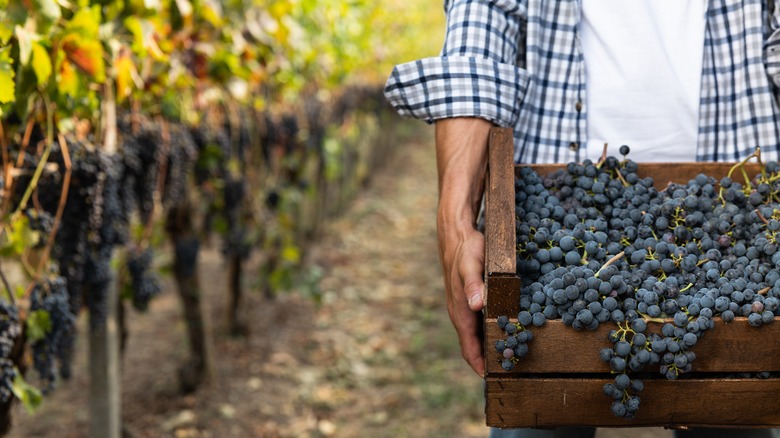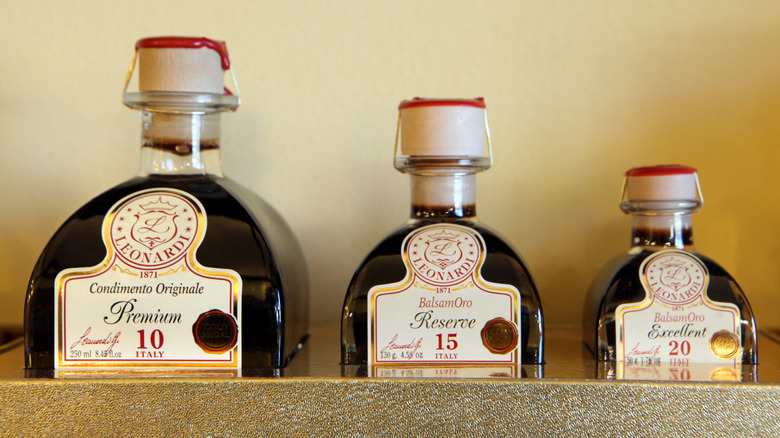The Stunning Number Of Grapes It Takes To Make A Single Bottle Of Wine
I had the privilege of working at a winery for several years and, while I was there, I observed several harvest seasons. During these times, which took place in the autumn months, there was a constant flow of huge vats of freshly picked grapes coming in from the vineyards in the wee hours of the morning; masses of Cabernet Sauvignon were crushed, and literal tons of Vermentino were pressed. It was a 24/7 operation of constant movement and activity, and it was all done to create hundreds of barrels and thousands of bottles of wine. I always wondered just how many of those grapes went into a single one of those bottles.
Many experts agree that it takes about 3 pounds of grapes to make a standard 750-milliliter bottle of wine, which is the equivalent of about 3 cups of liquid. In fruit, that's around 600 to 800 grapes per bottle. Of course, there are many factors that go into the answer including the size of the grapes, the winemakers' practices, and even the growing conditions of a particular year of grape production. So, for some varietals (typically those with smaller fruit, like Muscat grapes), the grape count might be closer to or even well over 1,000.
From vine to bottle
If you were to place 800 grapes next to a solitary wine bottle, your first thought might be along the lines of, "There's no way." Obviously, the juice alone from the grapes takes up much less room than the whole fruit, but grapes aren't merely juiced before they are bottled; several steps go into the meticulous process that is winemaking. Once grapes are harvested, they are crushed. And while the romanticized image of grape crushing often involves bare feet and an enormous wooden barrel, this really isn't how things are done anymore. Large crushing machines de-stem the grapes and leave behind the juice, skins, pulp, and seeds. All of these elements then begin to ferment, or create alcohol.
Next, the grape juice is separated from any solids. The winemaker will determine whether or not they want to use the first pressing juice, which is the juice that naturally runs off, or if they will also press the solids and extract every bit of juice those are holding as well. This decision plays a large part in determining the number of grapes it takes to fill a wine bottle. If the solids are pressed, the grape count decreases because you're getting more juice per grape. Finally, the strained juice (which is technically wine at this point) will either go directly into bottles or into steel tanks or barrels for aging. And that's basically how you fit hundreds of grapes into a standard wine bottle.
Save those grape solids
When it comes to another product that is made from grapes, balsamic vinegar, the grape count goes sky high. Authentic balsamic is made with one ingredient: grape must, which is another term for the aforementioned seeds, pulp, and skins of grapes after they are crushed. There is still a tiny bit of liquid clinging to those solids, as well. The must is cooked down and reduced, then aged for at least 12 years until the resulting vinegar is bottled. Because there is much less of the grape to work with when compared to wine, it takes about 100 kilograms of must (roughly 220 pounds) to make just a few liters of vinegar. This amount of grape must comes from 200 kilograms of fresh grapes, or over 440 pounds.
So, if you ever get into crafting homemade wine, save those grape solids once you've bottled your fermented grape juice, because you can then venture further into vinegar making as well. But, be aware, it's going to take a heck of a lot more than 800 grapes to make even a dropper full of vinegar.


